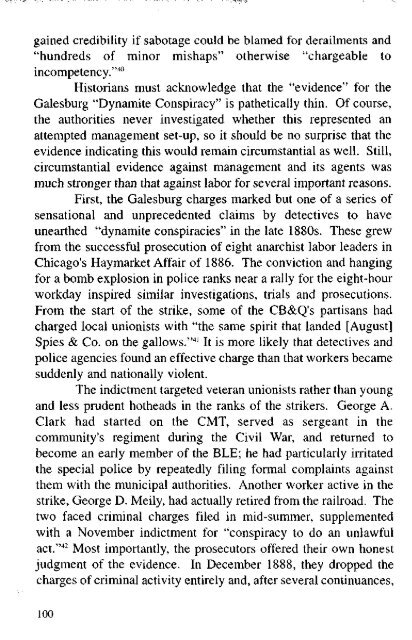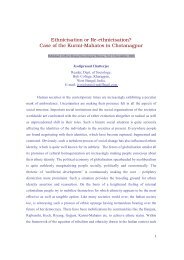"The Cruel Striker War" - NIU Digital Projects
"The Cruel Striker War" - NIU Digital Projects
"The Cruel Striker War" - NIU Digital Projects
You also want an ePaper? Increase the reach of your titles
YUMPU automatically turns print PDFs into web optimized ePapers that Google loves.
gained credibility if sabotage could be blamed for derailments and<br />
"hundreds of minor mishaps" otherwise "chargeable to<br />
incompetency." 40<br />
Historians must acknowledge that the "evidence" for the<br />
Galesburg "Dynamite Conspiracy" is pathetically thin. Of course,<br />
the authorities never investigated whether this represented an<br />
attempted management set-up, so it should be no surprise that the<br />
evidence indicating this would remain circumstantial as well. Still,<br />
circumstantial evidence against management and its agents was<br />
much stronger than that against labor for several important reasons.<br />
First, the Galesburg charges marked but one of a series of<br />
sensational and unprecedented claims by detectives to have<br />
unearthed "dynamite conspiracies" in the late 1880s. <strong>The</strong>se grew<br />
from the successful prosecution of eight anarchist labor leaders in<br />
Chicago's Haymarket Affair of 1886. <strong>The</strong> conviction and hanging<br />
for a bomb explosion in police ranks near a rally for the eight-hour<br />
workday inspired similar investigations, trials and prosecutions.<br />
From the start of the strike, some of the CB&Q's partisans had<br />
charged local unionists with "the same spirit that landed [August]<br />
Spies & Co. on the gallows." 41 It is more likely that detectives and<br />
police agencies found an effective charge than that workers became<br />
suddenly and nationally violent.<br />
<strong>The</strong> indictment targeted veteran unionists rather than young<br />
and less prudent hotheads in the ranks of the strikers. George A.<br />
Clark had started on the CMT, served as sergeant in the<br />
community's regiment during the Civil War, and returned to<br />
become an early member of the BLE; he had particularly irritated<br />
the special police by repeatedly filing formal complaints against<br />
them with the municipal authorities. Another worker active in the<br />
strike, George D. Meily, had actually retired from the railroad. <strong>The</strong><br />
two faced criminal charges filed in mid-summer, supplemented<br />
with a November indictment for "conspiracy to do an unlawful<br />
act." 42 Most importantly, the prosecutors offered their own honest<br />
judgment of the evidence. In December 1888, they dropped the<br />
charges of criminal activity entirely and, after several continuances,<br />
100

















